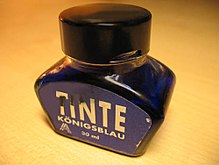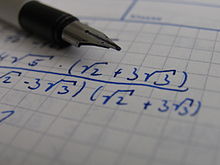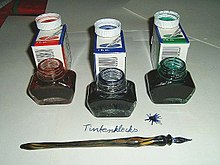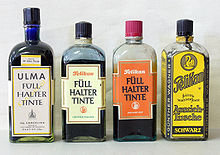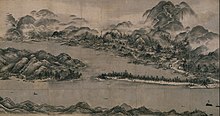ink
Ink ( Latin: tincta [aqua] "colored water") is an intensely colored and coloring liquid . In addition to manual application with quills , brushes or fountain pens when writing , in calligraphy and drawing , automated inkjet processes are also becoming increasingly important in word processing and product labeling. Ink mostly consists of a solution or dispersions of colorants in water or other solvents that contain little or no binders .
Indian ink is a special form of ink that is characterized by a strong color due to its pigmentation. It often contains a binding agent and the lettering is waterproof.
history
Ink was already in use in Egypt around 3000 BC. BC, in China around 2600 BC Used. Ordinary black ink was made from carbon black and various binders such as gum arabic for a long time ( carbon black ink ) and was not made until around 1000 BC. In the Far East replaced by Indian ink . This was made from the soot of burnt coniferous charcoal and lamp oil and mixed with a glue made of gelatine , pressed into sticks and dried. The ink stick was rubbed with water for use until the desired coverage was achieved. This method has survived in calligraphy .
An important invention in the 3rd century BC. BC was the production of iron gall ink by boiling gall apples with iron sulfate and then adding gum water. Iron gall ink is considered to be particularly resistant and is still used today as a document- proof ink.
Cicero reported for the first time about a recipe in which the ink pouches of squids were dried and pounded . The brown-black dye obtained from it is named after the generic name Sepia and is approved for coloring food. The use of sepia ink, however, is only documented from 1780.
In the Middle Ages, some formulations with different colored pigments were developed. Arsenic (III) sulfide reacted with mercury was used to obtain a gold-colored pigment for the production of the gold ink . Silver ink was used with a decorative effect. The spread of quills later led to the development of thorn bark ink, which did not dry out as quickly as iron gall ink and therefore clogged the pen head less often. The latter, however, remained the most frequently used recipe, especially for long-term documentation and in archives. A typical ink from the 15th to 18th centuries is the brown ink .
With the development of modern chemistry in the 19th century, a wide variety of dyes were discovered and used for writing and painting when possible. However, since water-soluble dyes often only have poor lightfastness and are also easily washable, guidelines for the composition of inks for creating permanent documents soon emerged. In 1856, for example, a recipe for an iron gall ink was published for the first time, the components of which only became water-insoluble after drying and which contained an artificial, water-soluble dye so that what was written on was visible even before it dried out.
There is now a wide range of inks available for various uses. The invention of automated systems such as the inkjet printer made inks necessary that combine special properties such as free miscibility (in order to be able to produce different colors) and extremely fast drying times.
Ink types
Inks with soluble colorants
In soluble ink, the dyes are chemically in the respective medium dissolved or as a complex bound. Advantages are easy handling, since the dyes cannot deposit ( sediment ) and thin feathers or nozzles are also not clogged. The often poor lightfastness and resistance to chemicals are disadvantageous.
Water based ink
Water-soluble inks are mainly used for writing or marking on paper , as aqueous inks do not penetrate the paper and the drying speed is not so important. Aqueous inks dry much more slowly than inks based on other binders and solvents. In countries with high humidity, solvent-based inks are used for applications on smooth surfaces.
Iron gall ink
Modern iron gall inks are structured in two stages. In the liquid, iron (II) sulfate and gallate are present in colorless solution, the dark color (to follow the lettering) is achieved by a likewise soluble dark dye. When drying in the air, the iron (II) is then oxidized to iron (III) and the deep black colored iron (III) gallate complex is formed . Therefore, iron gall inks have a limited shelf life after opening.
Due to the widespread use of iron gall ink in the past, the long-term reactions between constituents of the ink and the writing grounds used are of enormous importance for the preservation of documents. In the course of time, complex chemical reactions produce sulfuric acid and free iron (II) ions , which can decompose writing surfaces such as papyrus or paper . Based on acid corrosion , this process is also called ink corrosion . While chemical measures have been used as countermeasures in the last few centuries (including nitrocellulose ), modern methods concentrate only on the gentle neutralization of the acid and on restoring the paper's stability (for example using the paper splitting process ).
Ancient Indian ink
In India, ink was previously made from cow urine for Indian yellow , pulp and various tree bark and often with the blood of eels or catfish , rust from iron tools or nails was also added for an intense black hue.
Solvent-based ink
Solvent-based ink (dissolving Indian ink) is mainly used for writing on smooth surfaces (glass, foils). It shows through very strongly and runs on paper. Possible solvents are mostly ethanol and ethyl acetate or other carboxylic acid esters , in rare cases toluene and xylene . These solvents have the property of evaporating very quickly and independently of the air humidity and thus forming a dry film more quickly. In the meantime, German manufacturers only use denatured ethanol (alcohol) as a solvent base , as this agent is the least harmful to health.
Inks with insoluble colorants
Pigmented inks
In contrast to the dyes, pigments cannot dissolve chemically in the medium, but are only slurried, better still dispersed . Pigmented inks have the advantage of high color strength, high lightfastness, high water resistance and chemical resistance (this is particularly important if the ink is to be document- proof). A disadvantage that should be mentioned, however, is that pigments settle relatively quickly on the bottom if their density differs from that of the solvent, which is why the pigments are often particularly stabilized in inks. The larger the pigment particles, the faster they usually sediment. In whiteboard inks particularly crude pigments are needed in order to remain no pigments while wiping. In contrast, the pigments used in highlighters are particularly fine (0.1-0.4 micrometers).
In the case of light colors (such as yellow, red, orange), dye-based inks can be easily distinguished from pigmented ones: In contrast to pigmented inks, dye-based inks are transparent in the glass (the liquid is transparent). With darker colors (blue, violet, green), dye inks appear almost black in the jar, pigmented inks are the same color in the jar as on the paper.
ink
The word tuschen for “to apply black paint” was borrowed from the French toucher “to touch” in the 17th century . The composition of Indian ink is not uniformly defined and the name is not a protected term . However, the ISO 9957 standard exists for drawing inks. In technical drawings, dissolving (with solvents; for foils) and non-dissolving inks are used. Indian inks contain colorants (pigments) and a binding agent that allows the colorants to adhere well to the paper. This binding agent can be an aqueous solution of shellac or it can consist of water-soluble synthetic resins, mostly acrylic resins dissolved in an alkaline solution (saponified) . With Shellac Soap waterproof mascara can be made - these inks can be scraped off with a blade from the paper.
In ink painting , artists' inks are used, which usually consist of fine soot, which is mixed with shellac soap, water and thickening agents. Far Eastern ink painting and calligraphy use stick inks that are rubbed with water on a special rubbing stone . Inexpensive “Chinatchen” are also commercially available, preferably dye-based inks with acrylic resin.
Colloquially, watercolors and opaque colors are sometimes referred to as India ink.
The gisal bowl is an ink container.
Other inks
Luminous ink
Due to the fluorescence of the color body, the coloring of the ink line is particularly intense and acts as a glow of the ink . From the incident light, especially from the daylight spectrum, a specific part, often the UV light , is absorbed by the coloring system of the dye and re-emitted as visible, long-wave light. The luminous ink produces more visible light than the surroundings, making it appear particularly colorful and luminous.
Gel ink
In the 1990s gel ink became more and more important. It is mostly pigmented, water-based thixotropic ink, sometimes dye-based. The special thing about these inks is their flow behavior . Gel ink shows a pseudoplastic behavior: at rest it is thick, but becomes thin under the action of shear forces . In the case of gel pens, the tip is liquefied by the writing ball. This makes them particularly well suited for the use of pigments, which tend to sediment in normal (thin) inks. Pigmented gels have the advantage over dye-based gels that the writing on damp paper does not bleed. So-called liquid gels have been around since the 2000s. These gels have a similar structure to normal gel inks, but are much thinner and are mostly based on dye. Compared to classic gels, they have the advantage that they write more smoothly and fluidly, because of their lower viscosity they penetrate the paper better and thus less spatter.
Secret ink
As secret inks inks are called, which are either not visible or change their properties after some time. They used to be called "sympathetic" or chemical inks. Already around 2000 years ago, secret inks were known that only became visible after treatment with heat (for example through milk). Inks that can only be “developed” using suitable chemicals or that can be made visible using special lamps were also common later on. Secret inks can be viewed as a branch of steganography , the secret writing. For some purposes there were inks at that time, which were initially visible, but after a while they disappeared (faded, lost color) or their color changed. These are also called women's inks because of their origin .
Many secret inks are based on organic acids which, when heated, accelerate the decomposition of the paper at the point described and thus become the first dark and thus visible. Another possibility to make the writing visible is a reaction with iodine , whereby the ingredients are oxidized and so emerge. This method is used in forensic science for the treatment of fingerprints .
Scented ink
Since 1660, inks have been provided with fragrances by adding essential oils , flower extracts and perfume . The current range of scents ranges from natural scents (grass, flower, among which the lavender and rose scents from love letters are best known, other chocolate, fruit and various wood scents) to “technical scents”.
Ink for inkjet printers
The composition of inks for inkjet printers varies depending on the manufacturer and is usually not published. It is known that printer inks consist largely of water (between 50 and 90 percent) as well as dyes and other chemicals. The purity of the water is particularly important. The ink is adapted to the respective devices and nozzles. They have to meet some technical requirements that regular ink does not have to meet. They must not dry out in the printhead, but should dry quickly (knock away) on the paper. The corresponding values for the drying speed are only known to the manufacturers. The flow properties are tied to narrow limits, as the smallest possible droplets should be jetted in order to produce a clean print image.
For most printers, "replica" cartridges, refill inks or refilled original cartridges are available. Due to the large price difference between original and refill cartridges, printer manufacturers often take legal action ( patent law ) or with marketing means against the sometimes well-known second manufacturers and refillers to secure their sales . Other protective measures are the integration of ICs ( dongles ) that prevent refilling or replacement with products from other manufacturers. These price differences are based on commercial considerations of the printer manufacturers, who subsidize the purchase price of the printer with expensive inks.
Depending on the printing principle of the inkjet printer, so-called piezo inks are produced for the piezoelectronic process and thermoactive inks are produced for the thermal process, in which the evaporation should result in tiny droplets.
Color of inks
The color of an ink depends on the type of dye used. Virtually any soluble or insoluble dye can be used in modern inks as long as a suitable solvent or binder is present. While pigments have a characteristic inherent color, the color of a dissolved dye or a complex can depend on the solvent used. This means that the ink can have a different color than the dried lettering.
- Blue triphenylmethane dyes (often derived from resorcinol ) such as Helvetia blue or water blue are often used for writing because of their good water solubility . The dyes can be destroyed with an ink killer so that the lettering becomes invisible.
- The dye eosin can be used for red inks .
- Acid indigo carmine will turn green .
- White inks with good coverage contain the same pigments as opaque white .
- The fluorescent dyes used in highlighters are often derived from fluorescein .
- For black inks that are supposed to have good covering power, pigment dyes, preferably carbon black , are used.
Ink-jet inks usually contain selected, low-salt and mostly lightfast dyes. For the black ink, the large ink jet printer manufacturers usually use the CI pigment Black 7 ( carbon black ) instead of a dye. This has excellent lightfastness, water resistance and depth of color. Direct Blue 199 , Acid Yellow 9 , Reactive Red 180 , Acid Red 52 or Direct Black 19 are also used as colorants . Various commercial dyes are traded with these color indications from an international directory of dyes according to the nomenclature of the Color Index .
use
particularities
Manufacturers advise against mixing different colored writing inks. Different soluble inks can contain either acid dyes or basic dyes , which can cause the dyes to flocculate when mixed . On the other hand, dispersing agents for stabilizing pigmented inks can lose their effectiveness, so that sediments or flakes form.
Before changing the ink, fountain pens should be cleaned with water, preferably with demineralized water .
Visual arts
The first artistic works drawn with ink were probably made in China or Japan . There, in addition to ink painting ( Japanese sumi-e ) on paper or silk, and the first forms of calligraphy , i.e. the artistic design of characters, developed. In Europe, many works created in medieval scriptoria contain decorations and calligraphic documents in different shades.
Since inks, in contrast to watercolors, move into the drawing ground, there is a distinct form of contrast between dark ink pigments and light drawing ground. Compared to solid drawing materials such as charcoal or graphite, there is no need for later fixing on the surface.
Marking the hierarchy
In authorities, but especially in ministries, there is a stipulation of the ink color with which file notes are attached to documents. Annex 2 to Section 13 (2) of the Joint Rules of Procedure of the Federal Ministries (GGO) provides that ministers use the "green pencil", parliamentary state secretaries the "violet pencil", state secretaries the "red pencil", department heads the "blue pencil" and sub-department heads the "brown pencil" to use. The tradition of using a different color depending on the rank in the hierarchy of authorities already existed in the Prussian administration. In the GDR, Section 57 (1) of the official regulations of the government of the German Democratic Republic of November 3, 1949 described the "green pencil" for the minister, the "red pencil" for the state secretary and the "blue pencil" for the head of the main department. The purpose of such instructions is that it can be determined afterwards who made which comments on documents.
Related topics
- Ink pen
- Excess ink used to be soaked up with writing sand , more recently with blotting paper .
- Rorschach test (also known as the inkblot test)
- from the Latin root word tincta go tincture and tincture back
literature
- Nicolaus Equiamicus : Small recipe book of historical inks. Bohmeier, Leipzig 2009, ISBN 978-3-89094-593-4 .
- Paul Martell: Some contributions to the history of ink. In: Journal of Applied Chemistry . Volume 26, No. 27, pp. 197-199, 1913, doi: 10.1002 / anie.19130262703 .
- Claus Maywald: Writing inks: an introduction. Wiegner Königswinter, 2003, ISBN 978-3-931775-05-6 .
- Armin Schopen: Inks and inks of the Arab-Islamic Middle Ages : Documentation - Analysis - Reconstruction: a contribution to the material culture of the Near East. In: Treatises of the Academy of Sciences in Göttingen, Philological-Historical Class. Volume 3, Volume 269, Vandenhoeck and Ruprecht, Göttingen 2006, ISBN 978-3-525-82541-9 .
- Petrus Maria Caneparius: De atramentis cujuscunque generis. London, 1660 ( secret and scented ink in Latin in Google book search).
Movie
- Ink. Documentary, USA, 2006, 43:20 min., Script and director: Beata Ziel, production: Actuality Productions, History Televisions Network Productions, series: Moderne Wunder (OT: Modern Marvels ), season 13, episode 48, German first broadcast: 30 September 2009 at ZDFinfo .
Web links
- Forty Centuries of Ink - Historical sources and citations Collection (English) ( Memento of 16 April 2013 Web archive archive.today ) (accessed on 10 December 2012)
- Conservation forum of the University of Münster - ink damage (accessed on December 10, 2012)
Individual evidence
- ↑ Vera Trost: Gold and Silver Inks Technological Investigations on Occidental Chrysography and Argyrography from Late Antiquity to the High Middle Ages. (Phil. Diss. Würzburg 1983), Otto Harrassowitz, Wiesbaden 1991, ISBN 978-3-447-02902-5 .
- ↑ Prof. Blume, Dagmar Wiechoczek: iron gall ink. March 26, 2015, accessed June 18, 2018 .
- ^ Reviving Assam's ancient ink In: The Hindu . 19th March 2017.
- ^ Pietro Maria Canepari: De atramentis cujuscunque generis. Opus sane novum, hactenus a nemine promulgatum. In sex descriptiones digestum . excudebat JM Impensis Jo. Martin. Yes. Alestry, Tho. Dicas, apud quos veneunt ad Insigne Campanae, in Coemeterio Paulino, 1660 ( limited preview in Google book search).
- ↑ Fragrant letters
- ↑ Steam locomotive ink, airplane ink, soccer ink, golf ink, liquorice ink ( Memento from January 1, 2009 in the Internet Archive )
- ^ Officials: Red line . In: Der Spiegel . No. 39 , 1996 ( online ).
- ^ Official regulations of the government of the German Democratic Republic of November 3, 1949 ( Memento of March 25, 2014 in the Internet Archive ), Uni Marburg.de
